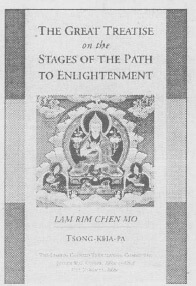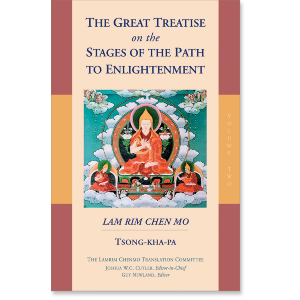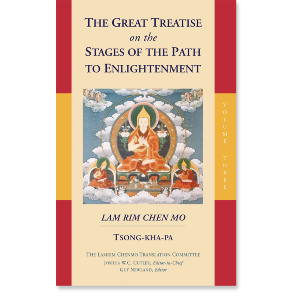| The following article is from the Autumn, 2002 issue of the Snow Lion Newsletter and is for historical reference only. You can see this in context of the original newsletter here. |

"One of the greatest religious or secular works in the library of our human heritage."—Prof. Robert A.F. Thurman, Columbia University
This much anticipated third volume (the full set is three vol.) contains a presentation of the two most important topics to be found in the Great Treatise: meditative serenity (shamatha) and supramundane insight into the nature of reality (vipasyana).
The Great Treatise on the Stages of the Path to Enlightenment (Lam rim chen mo) is one of the brightest jewels in the world's treasury of sacred literature. Tsong-kha-pa's text has continued to be essential for any student of Buddhist thought who wants to put the teachings into practice.
The following is an excerpt from the recently released third volume of The Great Treatise.

Focusing Your Mind
How to focus your mind on the object of meditation
This has three parts: (1) presenting the flawless method, (2) eliminating flawed methods, and (3) indicating the length of sessions.
(a) The flawless method
The concentration that you will accomplish here has two special features: vivid intensity—an intense mental clarity—and non-discursive stability, staying one-pointedly on the object of meditation. Some add bliss to these, making three features; others add limpidity as well, making four. However, limpidity is included in the first feature, so it does not to be listed as a separate item. Delight and bliss which impart a sense of well-being do occur as results of the concentration that you will accomplish here, but they are not concomitant with all of the concentrations which are included in the access to the first meditative stabilization. Also, the concentration of the fourth meditative stabilization—which is said to be the best basis for achieving the good qualities of all three vehicles—is not associated with any physical or mental bliss. Thus, delight and bliss are not counted as features here. While some of the concentrations on the formless levels lack highly vivid intensity, there is nothing wrong with presenting vividness as one of these features. For, Maitreya's Ornament for the Mahayana Sutras refers to "meditative stabilization" other than the formless realm. This means that bodhisattvas—except for some power bodhisattvas—achieve good qualities by relying on concentrations within the levels of meditative stabilization.
Since the development of this sort of vivid intensity is blocked as long as there is laxity, while one-pointed non-discursiveness is blocked as long as there is excitement, laxity and excitement are the chief obstacles to achieving genuine concentration. So if you do not understand how to identify accurately the subtle and coarse forms of laxity and excitement, or if you do not know how to correctly sustain a concentration which stops these once you have identified them, then it will be impossible for you to develop serenity, not to mention insight. Hence, those who diligently seek concentration should master these techniques.
Laxity and excitement are conditions unfavorable for achieving serenity. Later, I will discuss how to identify these unfavorable conditions and how to actually stop them. Now I shall explain how to develop concentration in a manner conducive to achieving serenity.
Here, concentration refers to your attention remaining one-pointedly on an object of meditation; in addition it must stay with the object continuously. Two tilings are needed for this: (1) a technique in which your attention is not distracted from whatever it had as its original object of meditation, and (2) an accurate awareness of whether you are distracted and whether you are becoming distracted. The former is mindfulness; the latter is vigilance. Vasubandhu's Commentary on the Ornament for the Malmyana Sutra (Mahahayana-sulmtamkara-bhasya,) states:
Mindfulness and vigilance bring about close mental focus because the former prevents your attention from wandering from the object of meditation and the latter clearly recognizes that your attention is wandering.
If a lapse in mindfulness leads to forgetting the object of meditation you will be distracted and will immediately lose the object upon which you are meditating. Therefore, the foundation of cultivating concentration is mindfulness which does not forget the object.
How does such mindfulness focus your mind right on the object of meditation? Once you have at least visualized the object of meditation in the minimal manner as explained above, generate a powerful apprehension of the object that tightly holds it with your attention. After you have set your attention at a high level, stabilize it on the object without newly analyzing anything.

Mindfulness directly and continually fastens your attention to the object of meditation. However, indirectly vigilance also focuses your attention on the object of meditation, for you depend on noticing actual or incipient laxity and excitement with vigilance, and then stabilize your attention on the primary object without falling under their influence.
With regard to mindfulness, Asanga's Compendium of Knowledge says:
What is mindfulness? In regard to a familiar object, your mind is not forgetful and operates without distraction.
This indicates that mindfulness has three features. (1) Its observed object is "a familiar object," since mindfulness does not occur with regard to a previously unfamiliar object. In this case, the image of a previously ascertained object of meditation appears. (2) Its subjective aspect or manner of apprehension is your mind's not forgetting the object, as indicated by the phrase "your mind is not forgetful." In this case, it is your mind's non-forgetfulness of the object of meditation.
What does non-forgetfulness mean? It is not mentioned in reference to merely being able to remember what your guru taught you about the object of meditation, thinking or saying, "The object of meditation is like this" when you cast your mind to it or when someone asks you about it. Rather, it refers to how your attention is fixed on the object of meditation and brings it to mind clearly without even the slightest distraction. If you are distracted, you lose your mindfulness to the extent that you are distracted. Therefore, after you have set your attention on the object of meditation in the manner explained above, you think, "In this way, I have fixed my attention on the object of meditation." Then, without new examination, you sustain the force of that awareness in unbroken continuity. This is the most critical point in the technique of maintaining mindfulness. (3) Its function is to keep your attention from wandering from the object of meditation.
Fixing your attention on an object of meditation in this way and controlling it is said to be like taming an elephant. An elephant trainer ties a wild elephant to a tree or sturdy post with many thick ropes. If it does as the trainer teaches it, then fine; if not, it is subdued and controlled, struck repeatedly with a sharp iron hook. Your mind is like the untamed elephant; you bind it with the rope of mindfulness to the sturdy pillar of an object of meditation such as I explained above. If you cannot keep it there, you must gradually bring it under control by goading it with the iron hook of vigilance. Bhavaviveka's Heart of the Middle Way states:
The erring elephant of your mind
Is securely bound by the rope of mindfulness
To the sturdy pillar of the object of meditation
And is gradually controlled with I he iron hook of intelligence.
Also, Kamalasila's second Stages of Meditation states:
With the ropes of mindfulness and vigilance, tie the elephant of your mind to the tree trunk, tire object of meditation.
It is not contradictory that the former text likens vigilance to an iron hook while the latter text compares it to a rope. Mindfulness directly and continually fastens your attention to the object of meditation. However, indirectly vigilance also focuses your attention on the object of meditation, for you depend on noticing actual or incipient, laxity and excitement with vigilance, and then stabilize your attention on the primary object without falling under their influence. Also, as cited above, the master Vasubandhu says that both mindfulness and vigilance focus your mind on the object of meditation.
It is said that you achieve concentration on the basis of mindfulness and that mindfulness is like a rope that actually fastens your attention to the object of meditation continuously, so mindfulness is the main technique to sustain in achieving concentration.
Also, mindfulness has a way of apprehending its object that carries a sense of certitude. If, while maintaining concentration, you stabilize your mind casually without a solid sense of certainty about the object, then your mind may take on a limpid clarity, but it will not have the vivid intensity of certain knowledge, so you will not develop powerful mindfulness. Therefore, as subtle laxity will be unchecked, only flawed concentration will ensue.
Those who cultivate just non-discursive attention without stabilizing their attention on other objects of meditation, such as divine body, bring to mind the personal instruction, Stabilize your mind without thinking of any object at all. Then they must keep their attention from being distracted and wandering. This non-distraction is synonymous with mindfulness that does not forget the object of meditation. Thus, since this meditation is simply the technique of maintaining mindfulness, those who meditate in this way must also rely on a mindfulness that carries the force of certain knowledge.



